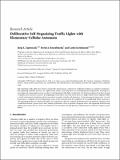| dc.contributor.author | Zapotecatl, Jorge L. | |
| dc.contributor.author | Rosenblueth, David A. | |
| dc.contributor.author | Gershenson Garcia, Carlos | |
| dc.date.accessioned | 2017-06-07T14:03:16Z | |
| dc.date.available | 2017-06-07T14:03:16Z | |
| dc.date.issued | 2017-05 | |
| dc.identifier.issn | 1076-2787 | |
| dc.identifier.issn | 1099-0526 | |
| dc.identifier.uri | http://hdl.handle.net/1721.1/109699 | |
| dc.description.abstract | Self-organizing traffic lights have shown considerable improvements compared to traditional methods in computer simulations. Self-organizing methods, however, use sophisticated sensors, increasing their cost and limiting their deployment. We propose a novel approach using simple sensors to achieve self-organizing traffic light coordination. The proposed approach involves placing a computer and a presence sensor at the beginning of each block; each such sensor detects a single vehicle. Each computer builds a virtual environment simulating vehicle movement to predict arrivals and departures at the downstream intersection. At each intersection, a computer receives information across a data network from the computers of the neighboring blocks and runs a self-organizing method to control traffic lights. Our simulations showed a superior performance for our approach compared with a traditional method (a green wave) and a similar performance (close to optimal) compared with a self-organizing method using sophisticated sensors but at a lower cost. Moreover, the developed sensing approach exhibited greater robustness against sensor failures. | en_US |
| dc.publisher | Hindawi Publishing Corporation | en_US |
| dc.relation.isversionof | http://dx.doi.org/10.1155/2017/7691370 | en_US |
| dc.rights | Creative Commons Attribution | en_US |
| dc.rights.uri | http://creativecommons.org/licenses/by/4.0/ | en_US |
| dc.source | Hindawi Publishing Corporation | en_US |
| dc.title | Deliberative Self-Organizing Traffic Lights with Elementary Cellular Automata | en_US |
| dc.type | Article | en_US |
| dc.identifier.citation | Zapotecatl, Jorge L.; Rosenblueth, David A. and Gershenson, Carlos. "Deliberative Self-Organizing Traffic Lights with Elementary Cellular Automata." Complexity 2017, 7691370 (May 2017): 1-15 © 2017 Jorge L. Zapotecatl et al | en_US |
| dc.contributor.department | Massachusetts Institute of Technology. SENSEable City Laboratory | en_US |
| dc.contributor.mitauthor | Gershenson Garcia, Carlos | |
| dc.relation.journal | Complexity | en_US |
| dc.eprint.version | Final published version | en_US |
| dc.type.uri | http://purl.org/eprint/type/JournalArticle | en_US |
| eprint.status | http://purl.org/eprint/status/PeerReviewed | en_US |
| dc.date.updated | 2017-06-07T08:22:24Z | |
| dc.language.rfc3066 | en | |
| dc.rights.holder | Copyright © 2017 Jorge L. Zapotecatl et al. This is an open access article distributed under the Creative Commons Attribution License, which permits unrestricted use, distribution, and reproduction in any medium, provided the original work is properly cited. | |
| dspace.orderedauthors | Zapotecatl, Jorge L.; Rosenblueth, David A.; Gershenson, Carlos | en_US |
| dspace.embargo.terms | N | en_US |
| mit.license | PUBLISHER_CC | en_US |
| mit.metadata.status | Complete | |
